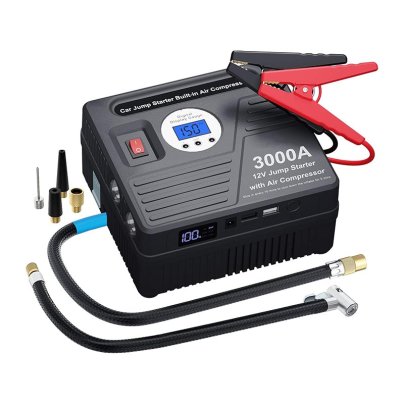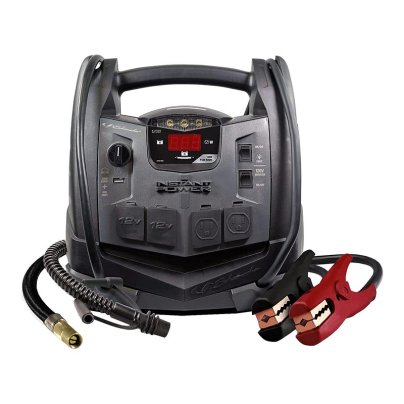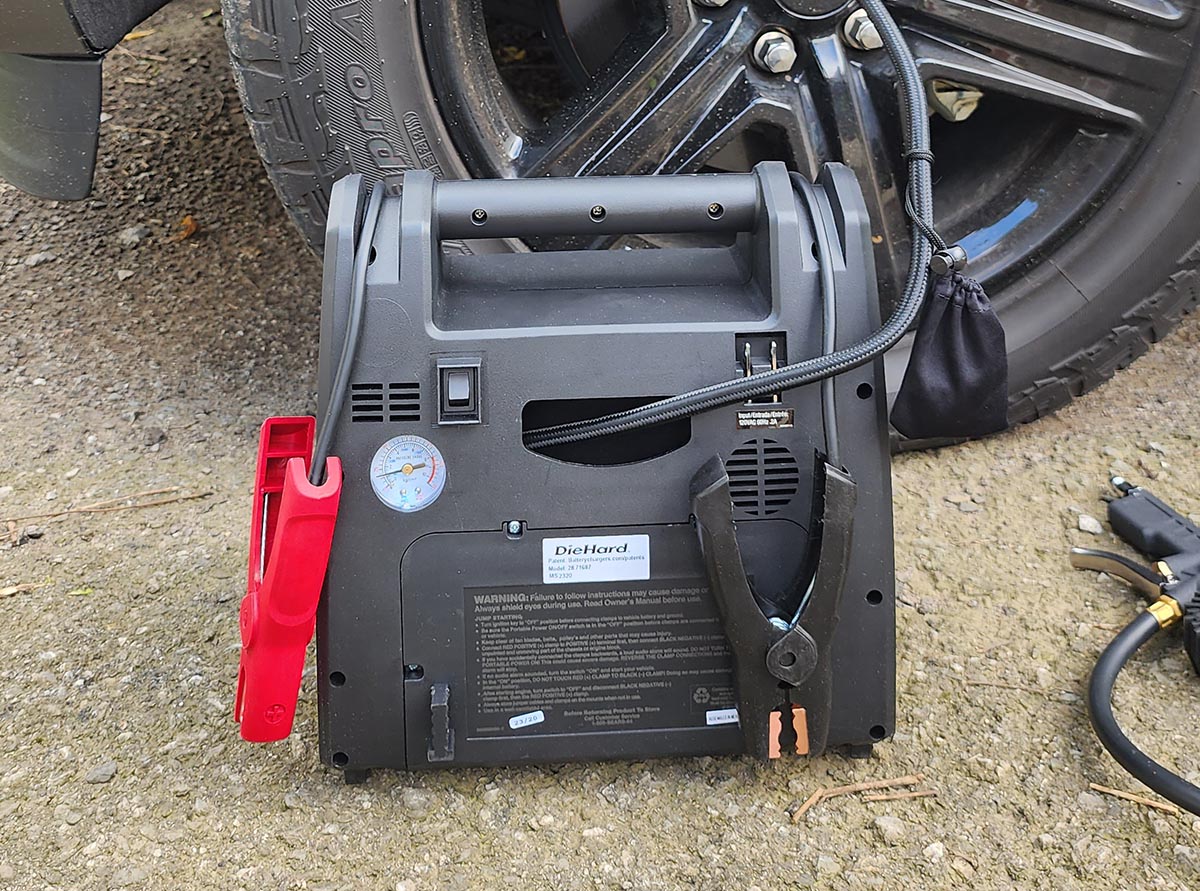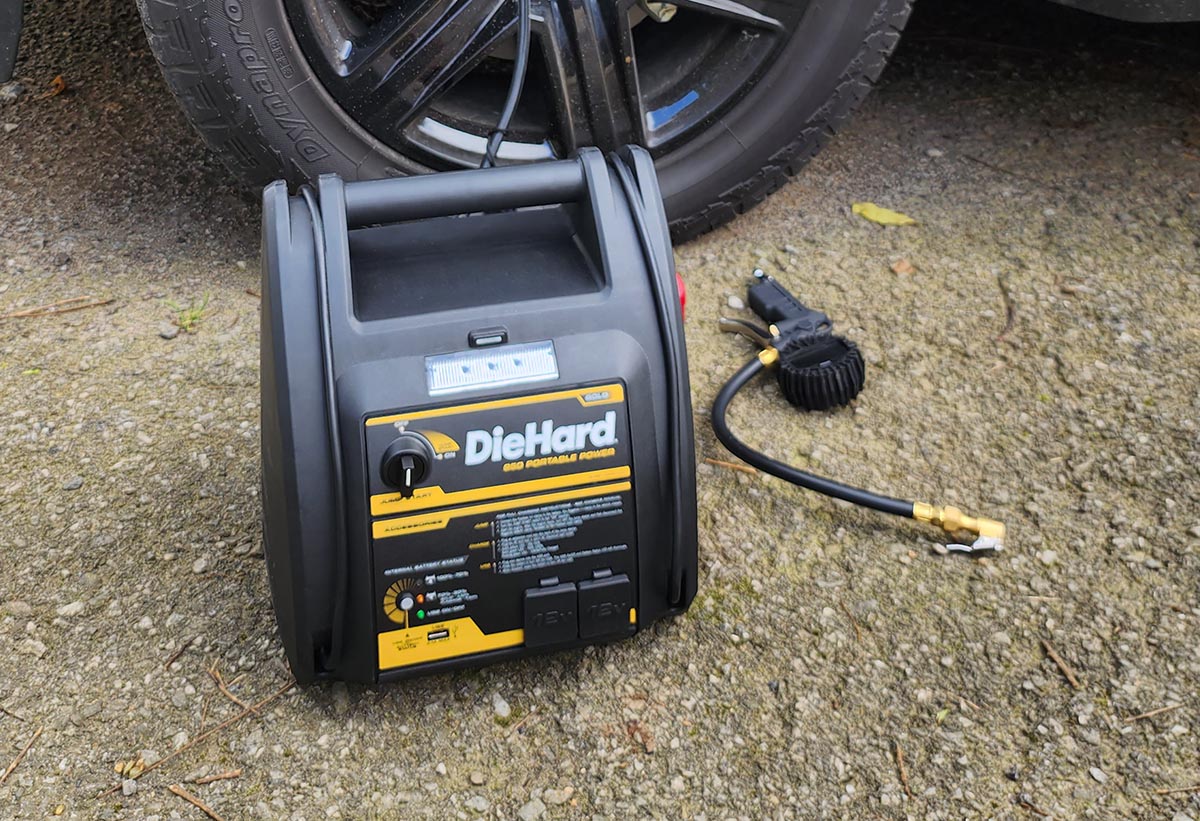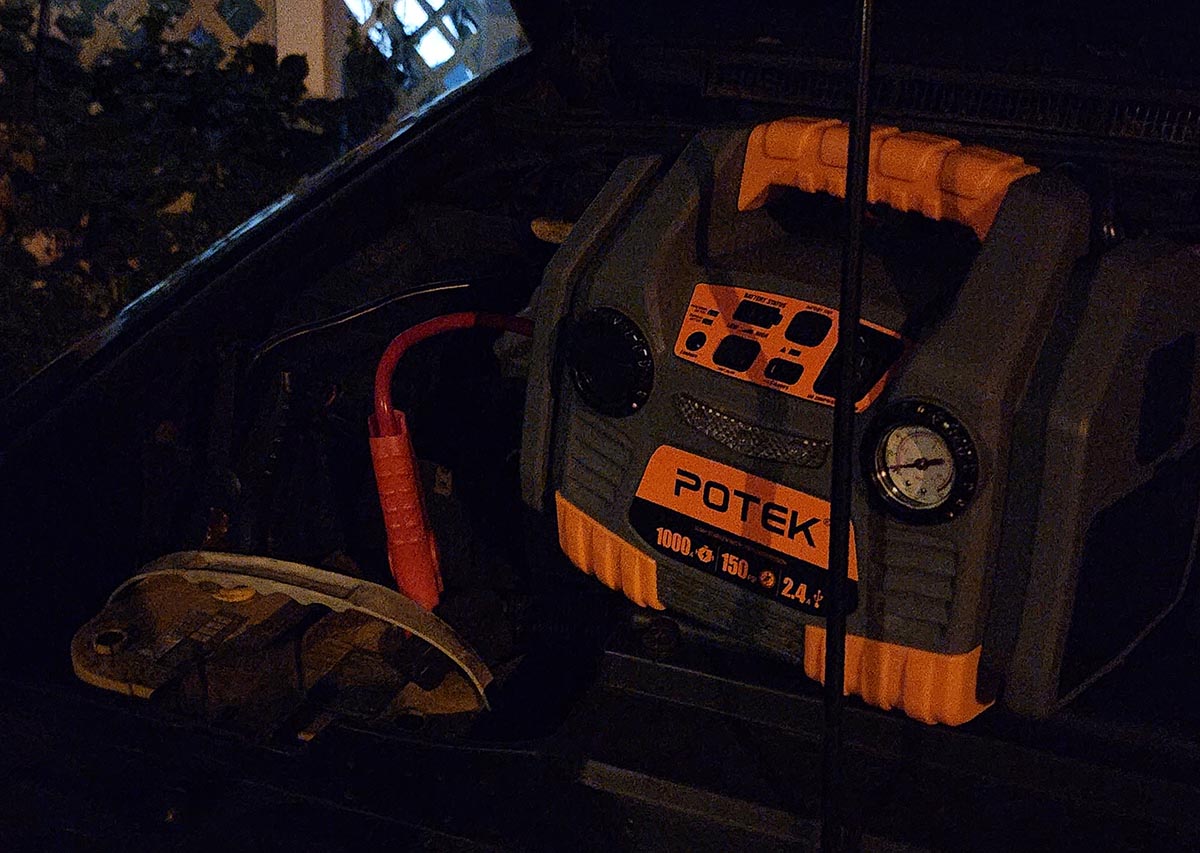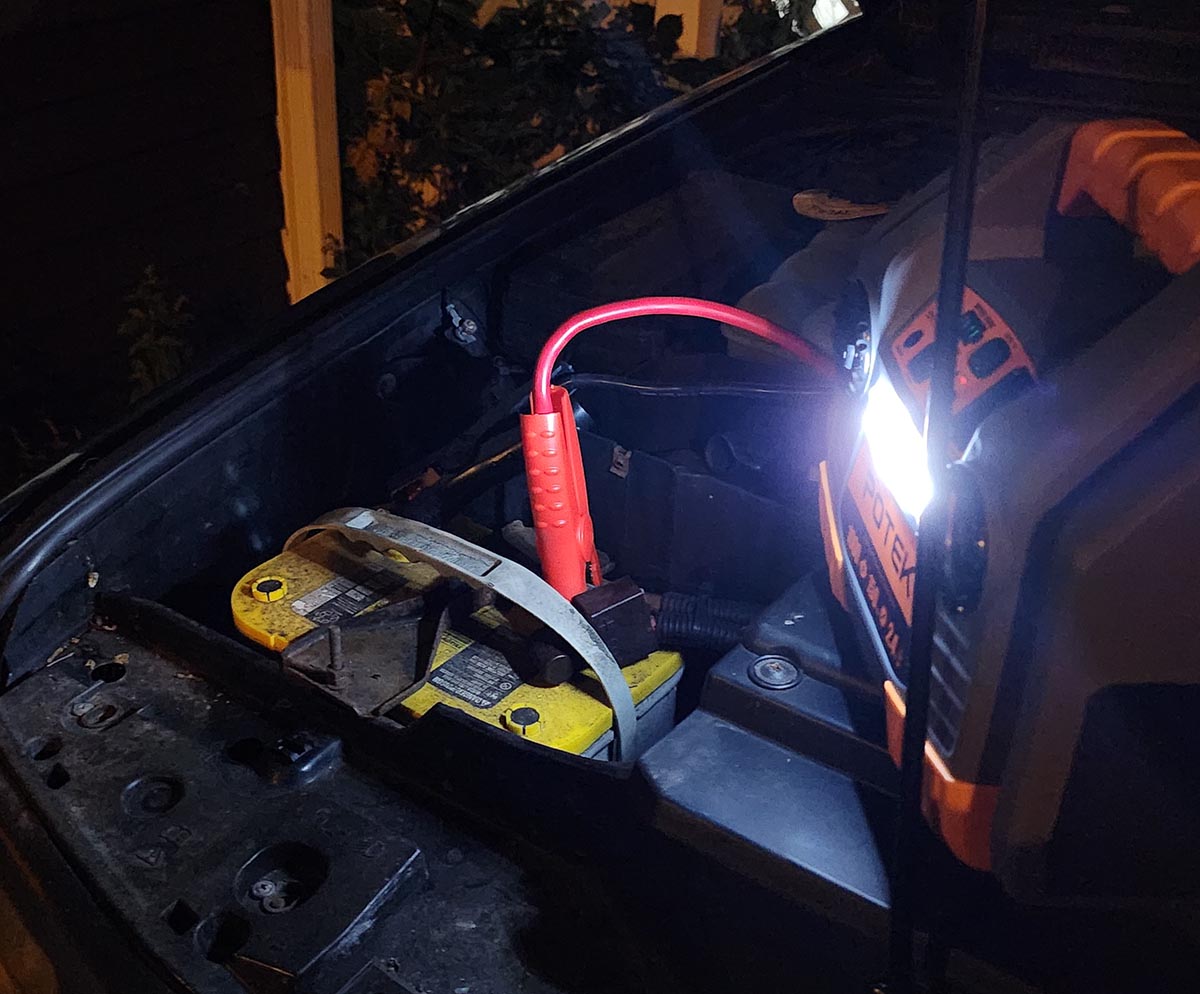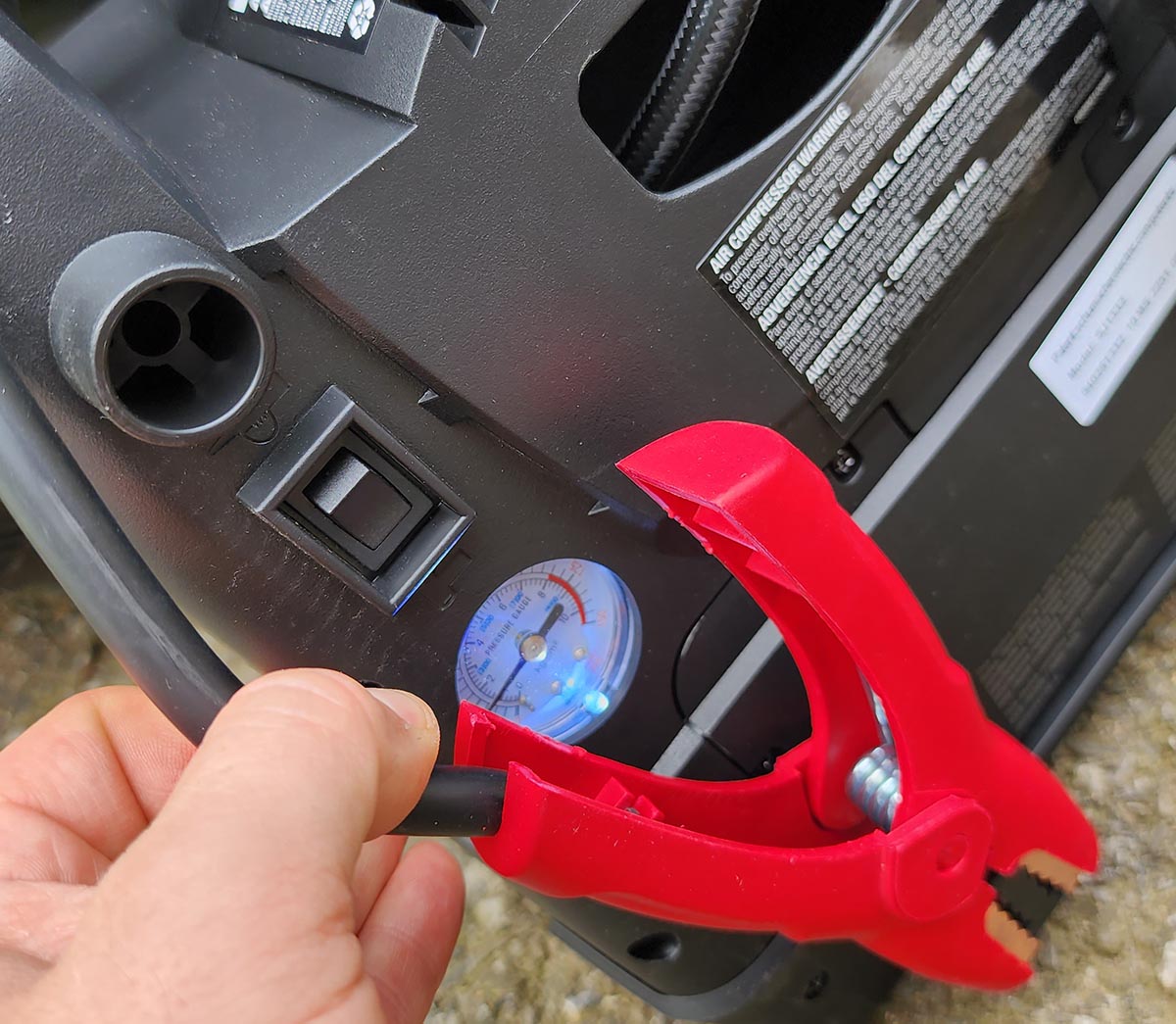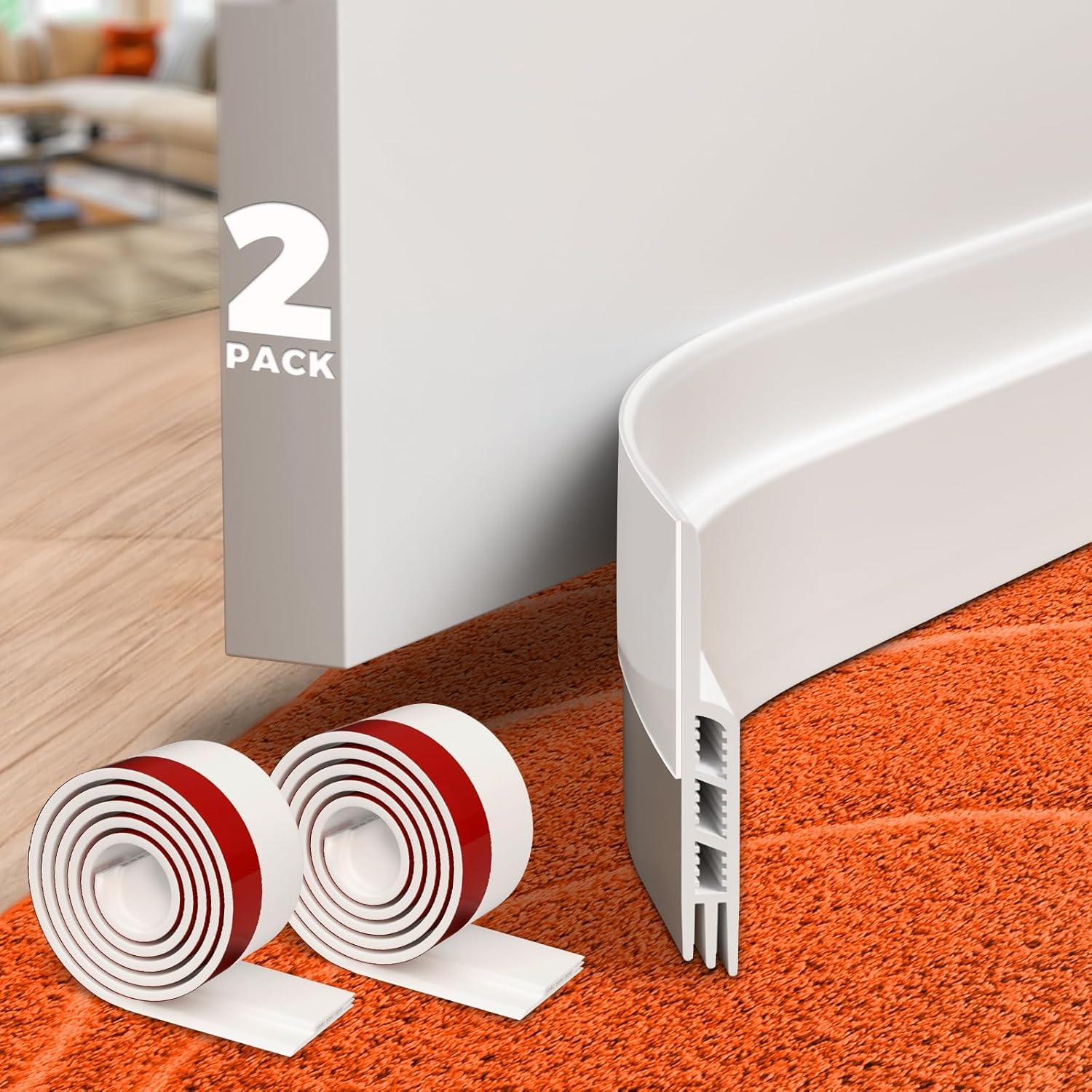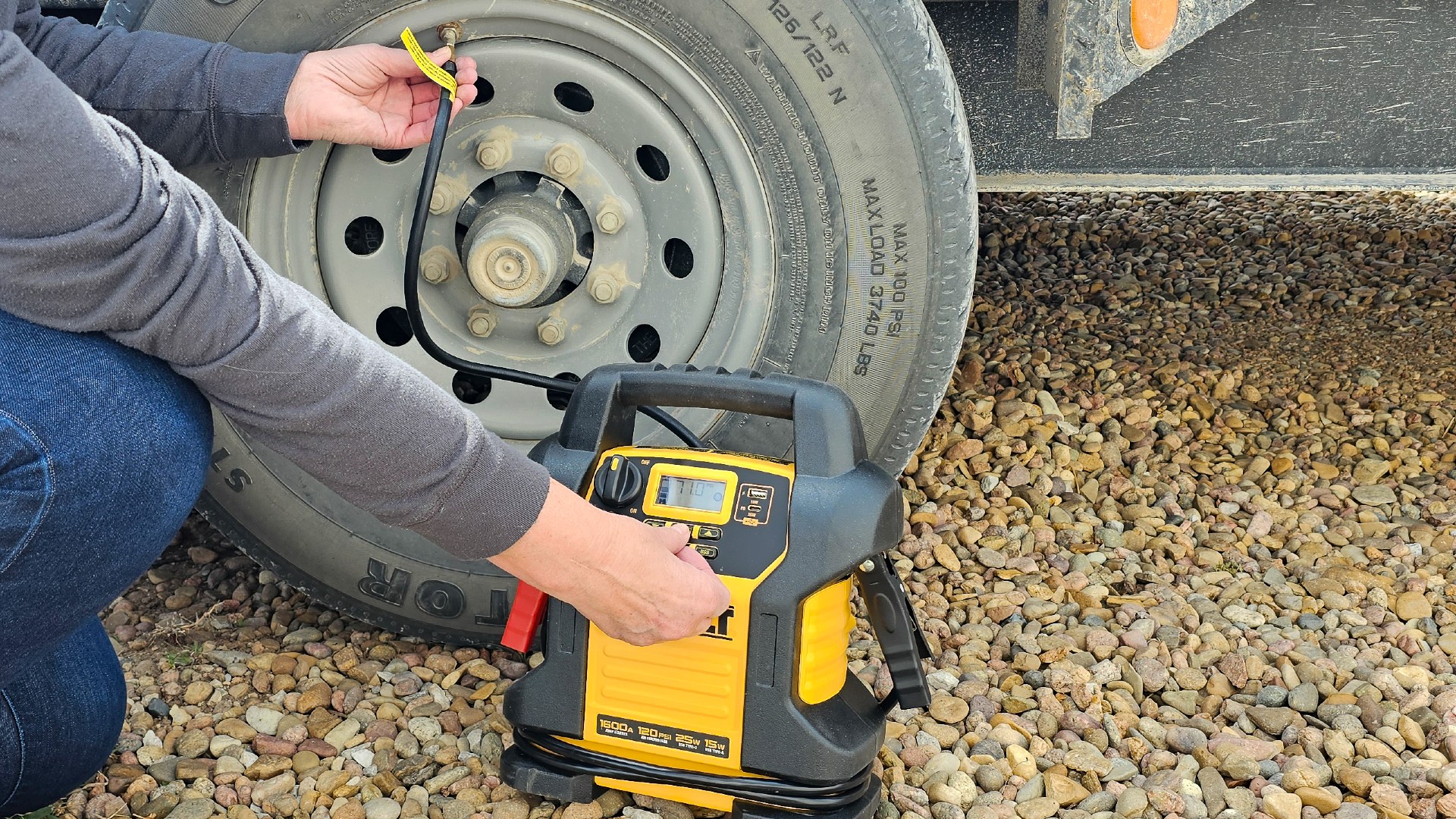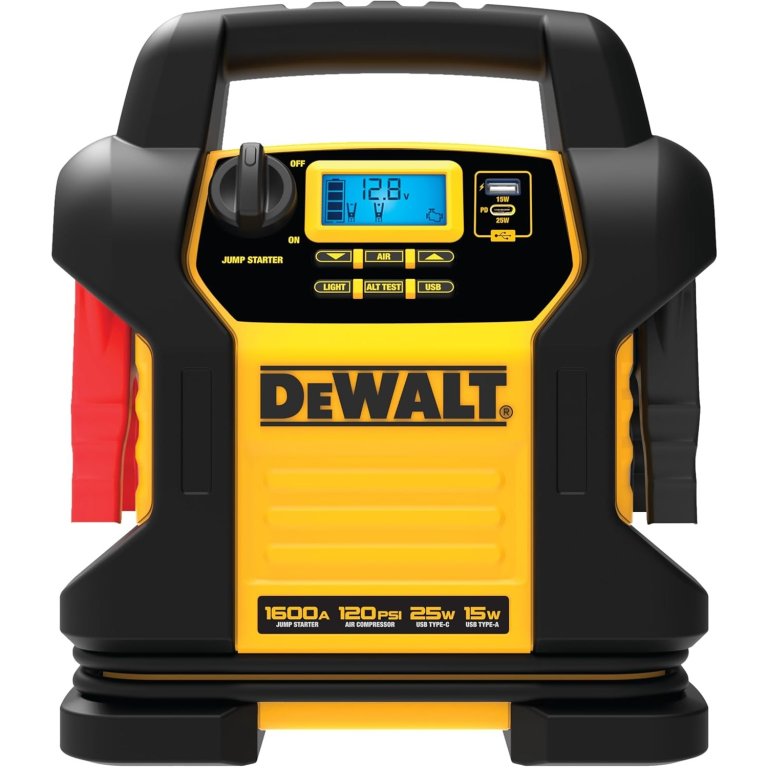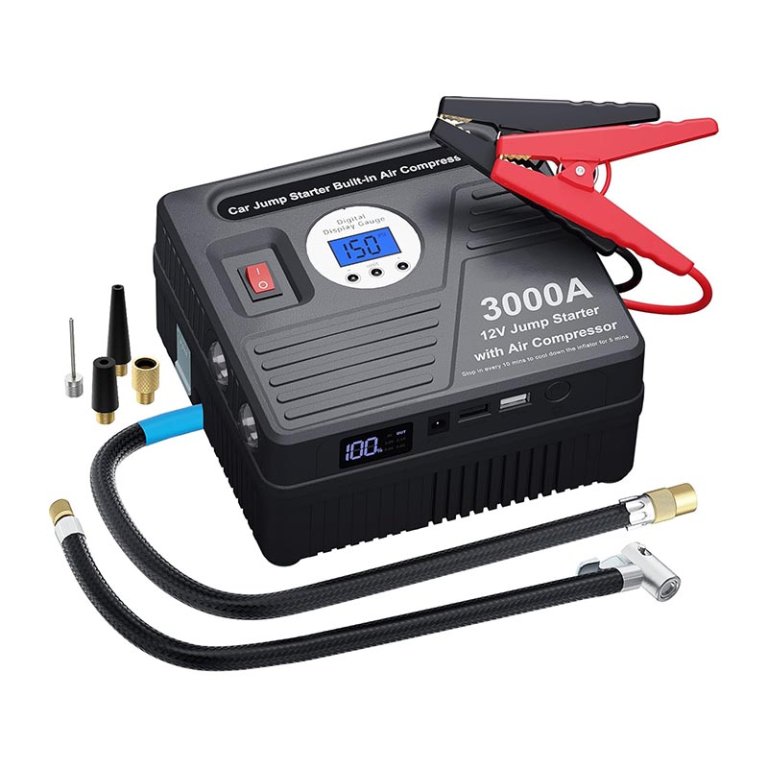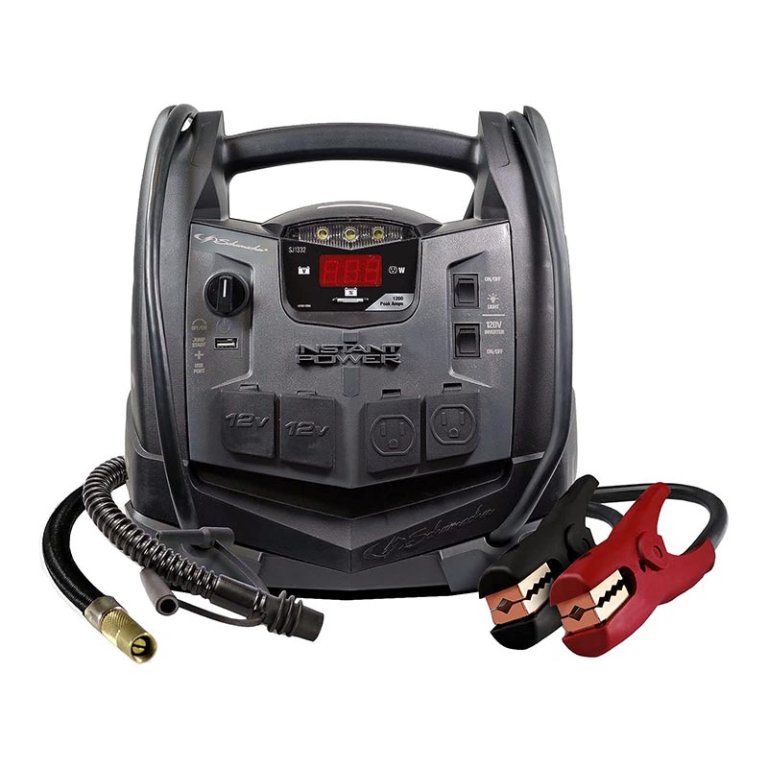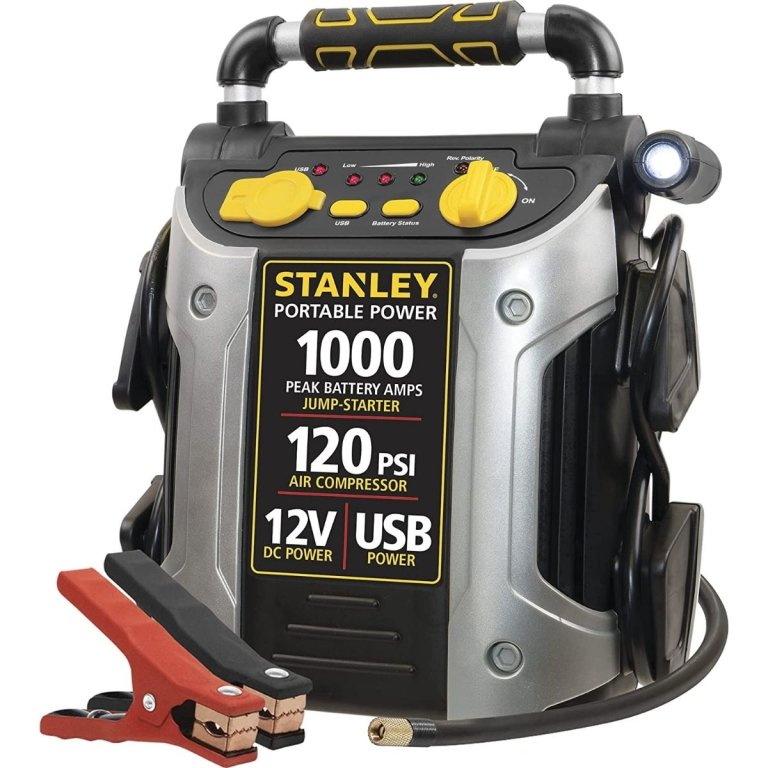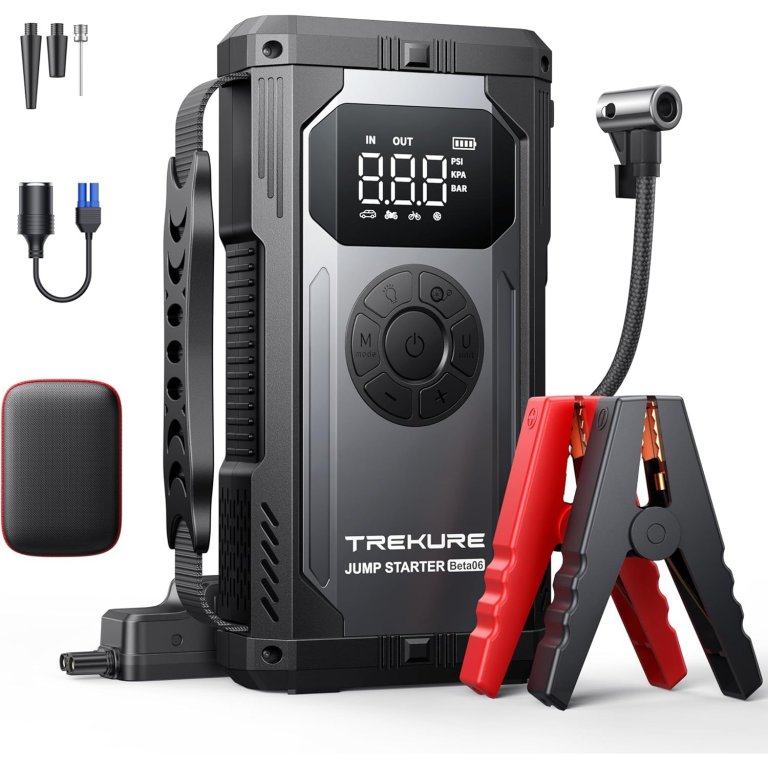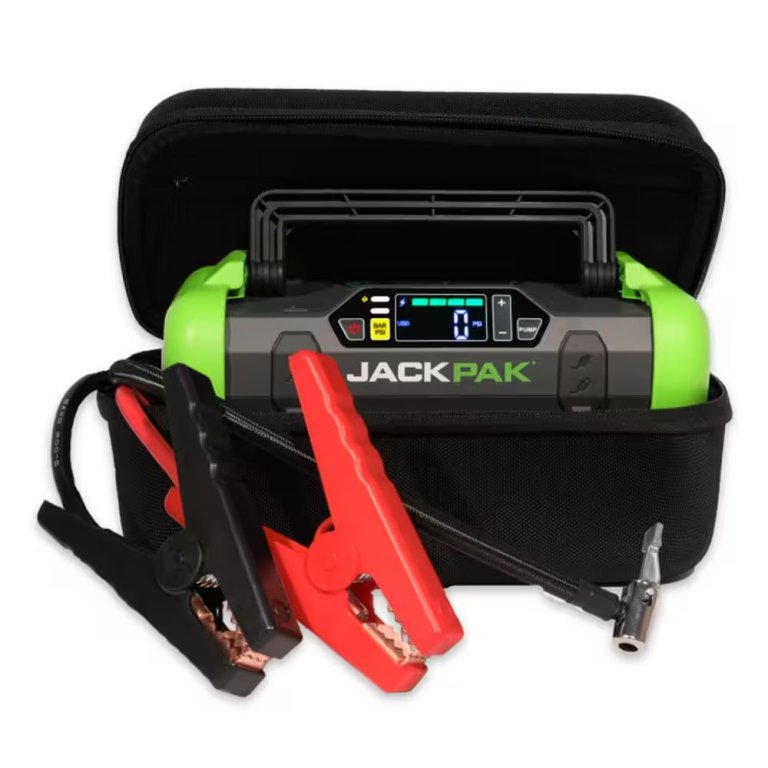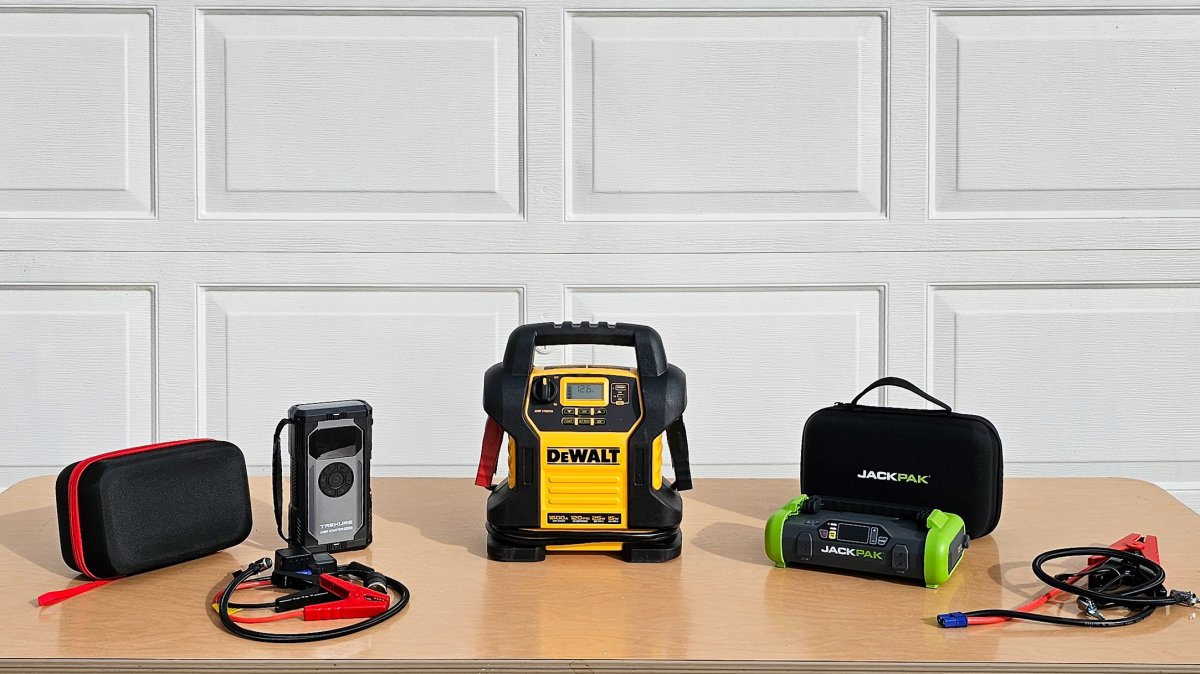
We may earn revenue from the products available on this page and participate in affiliate programs. Learn More ›
If you’ve ever tried to start your car, but the battery was dead, or you found a tire was too low to drive on, you may have wished for a jump starter air compressor. These combo tools claim to be able to get you going again—so we decided to put 11 of the top models to the test on our own vehicles, and found 7 that we can recommend. DeWalt’s 1600A Jump Starter with Air Compressor took top honors in our tests, thanks to its quality build, internal alternator tester, and convenient pressure presets for accurate inflation.
These devices bring enough voltage and amperage to bring a dead battery back to life. They can also fill a low tire or pump up a leaky one until the driver can make it to a service station for repairs. Ahead, learn the most important factors to consider when choosing one of these combo units and find out how the following models earned a spot on our lineup of the best jump starters with air compressors.
- BEST OVERALL: DeWalt 1600A Jump Starter With Air Compressor
↓ Jump to Review - BEST BANG FOR THE BUCK:JF.Egwo 3000A Car Jump Starter With Air Compressor
↓ Jump to Review - BEST OVERALL: Schumacher SJ1332 1200A Portable Power Station
↓ Jump to Review - BEST DUAL USE: DieHard 71687 950 Peak Amp 12V Jump Starter
↓ Jump to Review - BEST COMPRESSOR: Stanley J5C09 1000A Jump Starter With Compressor
↓ Jump to Review - BEST COMPACT: Trekure Portable Jump Starter With Air Compressor
↓ Jump to Review - ALSO CONSIDER: JackPak 150 PSI 2,500A Jump Starter with Compressor
↓ Jump to Review
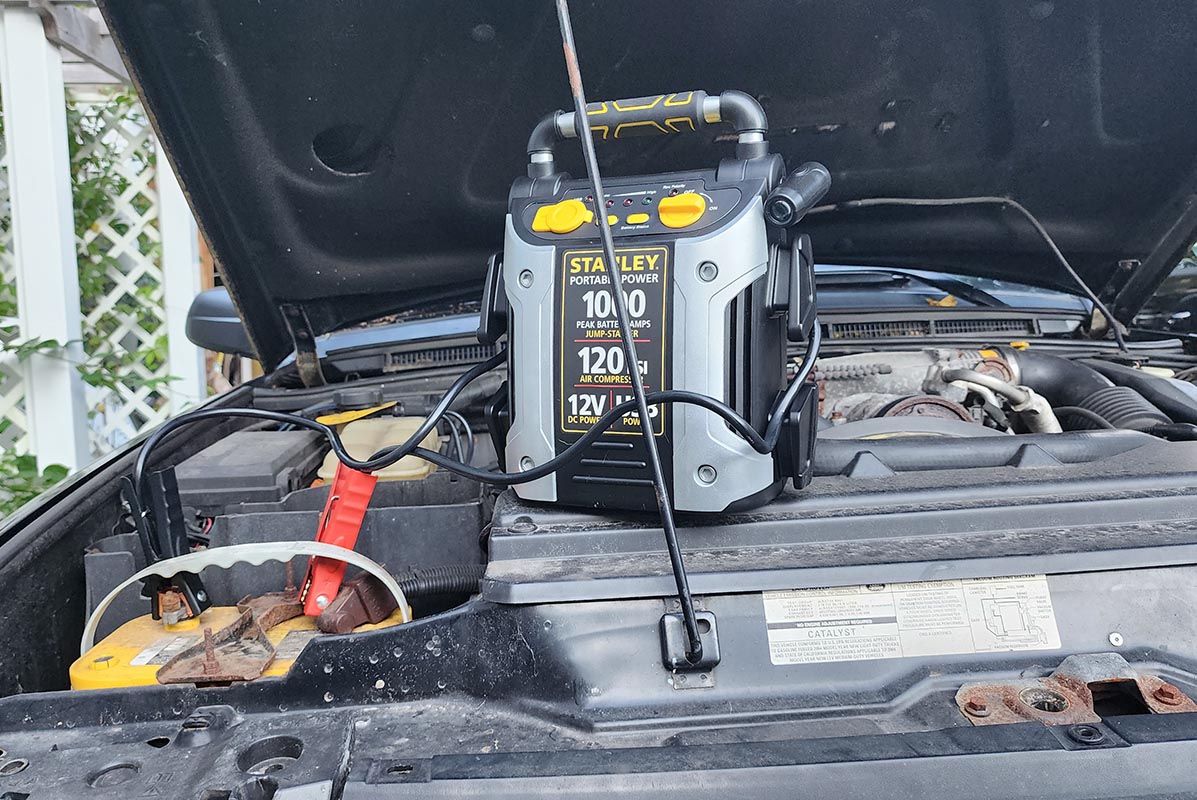
Jumper Starters With Air Compressors Comparison
| Product | Battery power | Air pressure | Additional features |
| DeWalt 1600A Jump Starter With Air Compressor | 1600A | 120 PSI | Alternator test, USB A, USB C, LED lights, Sports needle adapter |
| JF.Egwo 3000 Amp Car Jump Starter With Air Compressor | 3,000A | 150 PSI | 2 USB ports, 2 LED flashlights |
| Schumacher SJ1332 1200 Amp Portable Power Station | 1,200A | 150 PSI | 1 USB port, LED light, two 12V DC outlets, two 120V AC outlets |
| DieHard 71687 950 Peak Amp 12V Jump Starter | 950A | 150 PSI | 1 USB port, 2 power ports |
| Stanley J5C09 1000 Amp Jump Starter With Compressor | 1,000A | 120 PSI | 1 USB port, 1 power port, flashlight |
| Trekure Portable Jump Starter With Air Compressor | 5000A | 150 PSI | Flashlight, 2 USB ports, DC adapter |
| JackPak 150 PSI 2500A Jump Starter With Compressor | 600A | 150 PSI | Flashlight, road flare, USB-C port |
Our Top Picks
There might be a lot to know about these versatile devices, but shopping for the best jump starter with an air compressor doesn’t have to be complicated. To help make the process even easier, these top-rated products are an excellent starting point. We performed hands-on testing with every model listed below to ensure they can meet the grade.
Best Overall
DeWalt 1600A Jump Starter With Air Compressor
What We Like
- Built-in alternator test
- Powerful jump starter for car
- Battery voltage detection
- Preset pounds per square inch (PSI) prevents overinflation
What We Don’t Like
- Takes several minutes to inflate large tires
Specs
- Battery power 1600A
- Air pressure 120 PSI
- Additional features Alternator test, USB A, USB C, LED lights, Sports needle adapter
Our Ratings
| Ease of Use | 5/5 | Performance | 5/5 | Portability | 4.5/5 | Durability | 5/5 | Value | 4.8/5 |
The DeWalt jump starter/compressor combo performed flawlessly in our hands-on tests, easily earning the title of the best overall model. This unit supplies enough juice to start depleted batteries and has a built-in alternator tester.
We got an alternator reading by connecting it to a vehicle’s battery terminals when the vehicle was idling. Since problems starting a vehicle can be due to a faulty alternator, this feature is a nice perk.
The clamps are large and grip the terminals firmly. We were able to get a reading of the current battery voltage. When we connected the terminals to a fully charged battery, the DeWalt indicated the voltage, which is a good way to see the battery’s current charge.
The compressor measured the existing pressure in the tires. We were able to preselect the amount of air we wanted to add, and the compressor inflated the tires to the exact pressure. This handy feature removes the guesswork, especially when inflating bicycle tires that can explode if too much pressure is applied. It took about 20 seconds to inflate bike tires and about 5 minutes to inflate a large pickup tire.
What our tester says: “The DeWalt jump starter was a dream to use—its multifunctionality and high-quality performance made jumping batteries and filling tires almost effortless.” —Glenda Taylor, Product Reviews tester and writer
Get the DeWalt jump starter with air compressor at Amazon, Tractor Supply, The Home Depot, or Walmart.
Best Bang for the Buck
JF.Egwo 3000A Car Jump Starter With Air Compressor
What We Like
- Portable, compact unit
- Easy-to-read digital gauges
- Compressor is programmable
- Turns over large engines
What We Don’t Like
- No LED indicator
- Hose and fittings get hot during use
Specs
- Battery power: 3,000A
- Air pressure: 150 PSI
- Additional features: 2 USB ports, 2 LED flashlights
Our Ratings
| Ease of Use | 4/5 | Performance | 4.3/5 | Portability | 5/5 | Durability | 4/5 | Value | 4.5/5 |
For those looking for the most from a lithium-ion jump starter, this model from JF.Egwo is worth checking out. The jump starter features 3,000 amps (A) of power, allowing it to crank over gas engines up to 9 liters and diesel engines up to 8.5 liters. It also boasts a 24,000 mAh battery, giving this device the capacity to start up to 55 vehicles before recharging. With the included smart cables, there’s no risk to the electrical system.
The built-in air compressor produces up to 150 PSI, filling a flat tire in less than 15 minutes. The compressor includes two USB ports, two LED flashlights, an extension hose, and four air compressor nozzles for filling tires, sports equipment, air mattresses, and more.
The jump starter has an easy-to-read digital display, programmable to the desired tire pressure. Once this JF.Egwo model reaches that preset pressure, the compressor will shut off to avoid over-pressurizing the tire. The display also shows charge status and even the status of the unit’s battery.
This is a very compact jump pack, but we liked the design. The biggest drawback: The hose gets extremely hot while filling tires, and the brass fitting gets too hot to touch. We found we had to wait a few minutes to let the hose and fitting cool. Otherwise, we liked that this model has two digital gauges that are easy to read and understand, as well as the programmable gauge to shut off once it hits the set pressure.
We also liked that it came with a carrying case that holds everything inside it, including the jump pack. However, the cables are a little short and don’t feature any LEDs like other compact models.
Get the JF.Egwo jump starter with air compressor at Amazon.
Best Power Station
Schumacher SJ1332 1200A Portable Power Station
What We Like
- Easy to use, even in the dark
- Features multiple charging ports
- Can turn over an 8-liter gas engine
- Doubles as a power station
What We Don’t Like
- The analog gauge wasn’t accurate
- Analog gauge is in a difficult location
Specs
- Battery power: 1,200A
- Air pressure: 150 PSI
- Additional features: 1 USB port, LED light, two 12V DC outlets, two 120V AC outlets
Our Ratings
| Ease of Use | 5/5 | Performance | 5/5 | Portability | 5/5 | Durability | 5/5 | Value | 5/5 |
Folks who value versatility will want to consider the Schumacher SJ1332 rechargeable power station. This device features 1,200A of cranking power, allowing it to start a massive 8-liter gas engine or a 6-liter diesel engine. It also features a 150 PSI air compressor with an analog gauge for pumping flat tires and a high-volume air port for filling air mattresses and pool floats.
The Schumacher features two 12-volt (V) charging ports, two standard 120V outlets, and a USB port for charging mobile devices. This allows it to charge several devices or act as an emergency power station if the power goes out in the home. Its cables wrap around the unit and clip onto the base for storage, and the compressor hose stores in a small compartment in the back.
We weren’t big fans of the tire pressure gauge, which was not lit and wasn’t very accurate (a difference of around 8 PSI), and it’s in a weird spot (on the back of the jump pack and obscured by the clamp). But otherwise, the unit had plenty of power to jump the car and it was easy to use. We liked the 120V outlets.
What our tester says: “The Schumacher was relatively easy to use to jump my Land Rover. The light was helpful and allowed me to identify the cables easily at night, and the buttons and controls were fairly intuitive.” —Tom Scalisi, Product Reviews tester and writer
Get the Schumacher jump starter with air compressor at Amazon, Tractor Supply Co., Walmart, Northern Tool + Equipment, or Blain’s Farm & Fleet.
Best Dual Use
DieHard 71687 950 Peak Amp 12V Jump Starter
What We Like
- Long cables make it easy to use
- Comes with multiple power ports
- Compact and portable battery jumper
What We Don’t Like
- The battery gauge lacks detail
- Compressor gauge is in an awkward spot
Specs
- Battery power: 950A
- Air pressure: 150 PSI
- Additional features: 1 USB port, 2 power ports
Our Ratings
| Ease of Use | 5/5 | Performance | 5/5 | Portability | 5/5 | Durability | 5/5 | Value | 5/5 |
Jump starters with air compressors can be incredibly versatile, and this model from DieHard definitely fits the bill. The lead-acid jump starter offers 950 peak amps for cranking over large diesel engines as well as reverse hookup protection to avoid damaging the expensive electrical components that are sometimes vulnerable during jumping. It also features two 12V ports and a USB port for charging devices.
The compressor produces up to 150 PSI of pressure and includes a digital gauge for presetting the pressure and checking the battery’s charge level. A built-in work light makes working on the side of the road in low light a bit less difficult as well. This DieHard model also includes three air nozzle adapters for filling sports equipment, pool floats, and other items.
The DieHard jump starter was more than capable of firing up an old Land Rover. It was easier to attach than other models as the cables were slightly longer than the compact versions. And just a flip of the switch turned the unit on for the jumping function. We found that the air compressor worked well, pumping up the tire faster than the other full-size models (about 5 minutes faster from 20 PSI to 36 PSI), though the gauge is in a strange place—it’s right behind the positive clamp. Also, the battery gauge on the front of the unit isn’t all that detailed, providing only broad ranges: 70 to 100 percent, 30 to 70 percent, and under 30 percent.
Get the DieHard jump starter with air compressor at Amazon or Ace Hardware.
Best Compressor
Stanley J5C09 1000A Jump Starter With Compressor
What We Like
- Powerful compressor fills tires fast
- Control panel is intuitive
- Includes a 12V port and USB port
- LED light allows for safety
What We Don’t Like
- The light output is a bit weak
Specs
- Battery power: 1,000A
- Air pressure: 120 PSI
- Additional features: 1 USB port, 1 power port, flashlight
Our Ratings
| Ease of Use | 5/5 | Performance | 5/5 | Portability | 5/5 | Durability | 5/5 | Value | 5/5 |
For an additional well-rounded jump starter, Stanley’s J5C09 portable power station could fit the bill. This jump starter features a lead-acid battery with up to 10,000A of cranking power for turning over large engines in gasoline and diesel vehicles alike. It also includes a 120 PSI compressor that can fill nearly any tire, with an illuminated analog gauge for monitoring the pressure in real-time.
This unit provides some additional built-in features worth noting. It offers a USB port for charging devices, a standard 12V port, a reverse polarity alarm to indicate improperly installed clamps, and a positionable work light for shedding light on the repair area.
During the test, the one feature that stood out the most was the air compressor. It was able to fill a tire in much less time than the other models (about 4 minutes), and the analog display was very accurate. It’s also easy to set up and use in the dark, plus it features extra-long cables to make reaching battery terminals easier. It also had plenty of power to kick the vehicle’s engine over. The positionable light is a nice touch as it allowed us to position the jump pack carefully without losing our light source. The light is a bit weak, however.
Get the Stanley jump starter with air compressor at Amazon, MSC, or Walmart.
Best Compact
Trekure Portable Jump Starter With Air Compressor
What We Like
- Compact and portable
- Effective jump starting
- Bright flashlight/road flare
- Convenient carry case
What We Don’t Like
- Limited tire inflation power
- Clamps are on the small side
Specs
- Battery Power 5000A
- Air pressure 150 PSI
- Additional features Flashlight, 2 USB ports, DC adapter
Our Ratings
| Ease of Use | 4/5 | Performance | 4/5 | Portability | 5/5 | Durability | 4.5/5 | Value | 4.5/5 |
The Trekure jump starter fits a lot of energy into a small package, making it a good option for taking along on road trips. We didn’t have any problems jump-starting three different dead batteries, but the clamps are a little on the small side—we would have appreciated larger clamps.
This unit came with some battery charge, but once it was depleted by testing, it took about 6 hours to recharge. We liked its bright LED flashlight, which allowed us to see what we were doing after dark. The flashlight also doubles as a yellow flashing road flare that can be seen from a distance.
The inflator aired up our bicycle and car tires but didn’t have quite the oomph to fill up larger truck tires. But it’s simple to use—the display screen let us choose from images of a car, motorcycle, bike, or basketball for adjusting air pressure.
We like the Trekure for all-purpose 12-volt jump-starting, but we think it’s best suited for light-duty tire inflation. It comes in a handy case and includes two USB ports and a plug-in DC outlet for charging various devices in the car.
Get the Trekure jump starter with air compressor at Amazon.
Also Consider
JackPak 150 PSI 2500A Jump Starter With Compressor
What We Like
- Rugged build quality
- Fast recharge time
- Low power sleep mode
What We Don’t Like
- Slow truck tire inflation
Specs
- Battery power 600A
- Air pressure 150
- Additional features Flashlight, road flare, USB-C port
Our Ratings
| Ease of Use | 5/5 | Performance | 4.3/5 | Portability | 5/5 | Durability | 4.5/5 | Value | 4.7/5 |
If you’re looking for a multi-function jump starter/compressor combo, check out this new model from JackPak. Right out of the box, we were impressed with this unit’s build quality—it’s solid, rugged, and comes with heavy-duty clamps.
Like the DeWalt that earned our best overall award, the JackPak shows how many volts the current vehicle battery has, which is great if there isn’t a voltmeter handy. We wish all the units came with this feature.
It supplied enough juice to jump all three dead batteries and took less than three hours to recharge. The compressor feature inflated our bike, car, and truck tires, but it took nearly 30 minutes to completely fill the truck tire. Still, the JackPak isn’t meant as a replacement for a commercial tire inflator, but it will get the job done when a service station isn’t nearby.
We liked the bright LED light on the JackPak, and it doubles as a powerbank for charging devices. It also features a low-power sleep mode that keeps its internal battery from discharging for up to 36 months.
Get the JackPack jump starter with air compressor at Lowe’s or The Home Depot.
Jump to Our Top Picks

How We Tested the Best Jump Starters With Air Compressors
| Testing Stats | |
| Products tested | 11 |
| Time spent testing | 2 weeks |
| Tests performed | 4 |
| Price range | $75 to $300 |
When a battery goes dead and a car is stuck in a parking lot or across town (or the side of the road), there’s a lot on the line. We know that, so we tested the jump starters with air compressors on our own depleted car and truck batteries and to inflate a range of tires.
We tested each product by jumping a dead car, truck, and riding mower batteries. We also used a multimeter to determine the voltage from the jump starters. We tested the jump starters over a 2-week period, connecting each one to the various battery terminals and then attempting to start the vehicle.
We also drained some of the air from bike, car, and truck tires to test the built-in compressors. For the inflation tests, we partially deflated bike, car, and truck tires and then timed how long it took each inflator to return the tires to the recommended pressure. During these inflation tests, we paid close attention to how easily the air chucks connected to the valve stems, whether they created a secure seal, and how well they held up through repeated use. We also considered whether the compressors operated consistently under pressure or showed signs of strain, as well as how intuitive and responsive the controls were throughout the process.
We awarded points based on a rubric: the better a jump starter/inflator did on a test or assessment, the higher the points. The products that excelled were given awards based on their strengths, while those that failed were removed from our lineup.
| Product | Ease of Use | Performance | Portability | Durability | Value |
|---|---|---|---|---|---|
| Schumacher SJ1332 1200 Amp Portable Power Station | 5/5 | 4.3/5 | 4.5/5 | 5/5 | 4.7/5 |
| JF.Egwo 3000 Amp Car Jump Starter With Air Compressor | 4/5 | 4.3/5 | 5/5 | 4/5 | 4.5/5 |
| DieHard 71687 950 Peak Amp 12V Jump Starter | 4.5/5 | 4.8/5 | 4/5 | 4.5/5 | 4.5/5 |
| Stanley J5C09 1000 Amp Jump Starter With Compressor | 4.5/5 | 4.8/5 | 4/5 | 4.5/5 | 4.5/5 |
| Trekure Portable Jump Starter With Air Compressor | 4/5 | 4/5 | 5/5 | 4.5/5 | 4.8/5 |
| JackPak 150 PSI 2500A Jump Starter With Compressor | 5/5 | 4.3/5 | 5/5 | 4.5/5 | 4.7/5 |
| DeWalt 1600A Jump Starter With Air Compressor | 5/5 | 5/5 | 4.5/5 | 5/5 | 4.8/5 |
What to Consider When Choosing a Jump Starter With Air Compressor

Carrying a jump starter with an air compressor means drivers can handle emergencies and repairs without calling for help (or when help isn’t available). And who doesn’t enjoy a little self-reliance? These devices include built-in jumper cables to clamp onto the positive and negative terminals of a dead battery. It sounds straightforward, but shopping for one of these devices requires a bit of background and know-how. The following sections will break down the most important considerations to keep in mind while shopping for a battery jumper with air compressor.
Lithium-Ion vs. Lead-Acid
Jump starters equipped with air compressors include one of two battery types: lithium-ion and lead-acid.
- Lithium-ion jump starters are small, compact, and lightweight, but they pack plenty of power. They’re excellent for storing in small cars or for those with limited garage space. These devices are also ideal for anyone who struggles to carry a heavier battery pack.
- Lead-acid jump starters are constructed with older technology, and they’re bulky and heavy. However, many of these units include 110V outlets for running or charging small electronics, as well as USB ports for added versatility. They can easily weigh 50 pounds, so keep that in mind when shopping.
Battery Size

The best jump starters with air compressors—and all portable jump starters, for that matter—have an onboard battery that provides ample power to start a vehicle or operate the compressor. In most cases, the battery size of these portable chargers is described in milliampere hours (mAh) or amp hours (Ah)—1,000mAh equals 1Ah.
Higher mAh or Ah ratings equals a larger capacity to store power, so higher ratings mean more batteries charged and tires inflated between recharges. Generally speaking, most portable jump starters use batteries between 10,000 and 35,000mAh. Remember that higher capacity batteries are heavy, and get heavier as the storage increases.
Size and Type of Engine
The purpose of a jump starter is to provide a vehicle with enough power to turn over and fire up the engine, then allow the vehicle’s alternator to continue charging the battery. The amount of power a jump starter needs to accomplish this task is determined by the engine.
Small gasoline engines, such as four-cylinder engines found in most cars (and progressively larger vehicles) don’t require much power. But larger eight-cylinder engines require a bit more. And, because of the extremely high compression ratios of diesel engines, large models found in heavy-duty pickups, RVs, and power equipment require even more power. In general, 1,000A or more will do the trick.
Many manufacturers today don’t explicitly list the amount of power provided by their chargers. Instead, they discuss the types of engines their chargers can handle. This is only a concern for diesel vehicles, as any jump starter will handle most gasoline engines.
Jumper Cables
While it might seem that jumper cables are all created equal, modern jump starters offer additional safety features. Today’s models protect a vehicle’s electrical system and the person using the cables from sparking or reverse polarity, which happens when the user connects the clamps to the wrong terminals—something that’s very easy to do in the dark. Reverse polarity can wreak havoc on the sensitive electronics in today’s vehicles, so this is a crucial feature.
These units will detect the reverse polarity or contact between the clamps and prevent the unit from expelling stored energy through them. Often, a small light or audible alarm will alert the user so you can understand what’s occurring and why the jump starter isn’t charging the vehicle.
Air Pressure
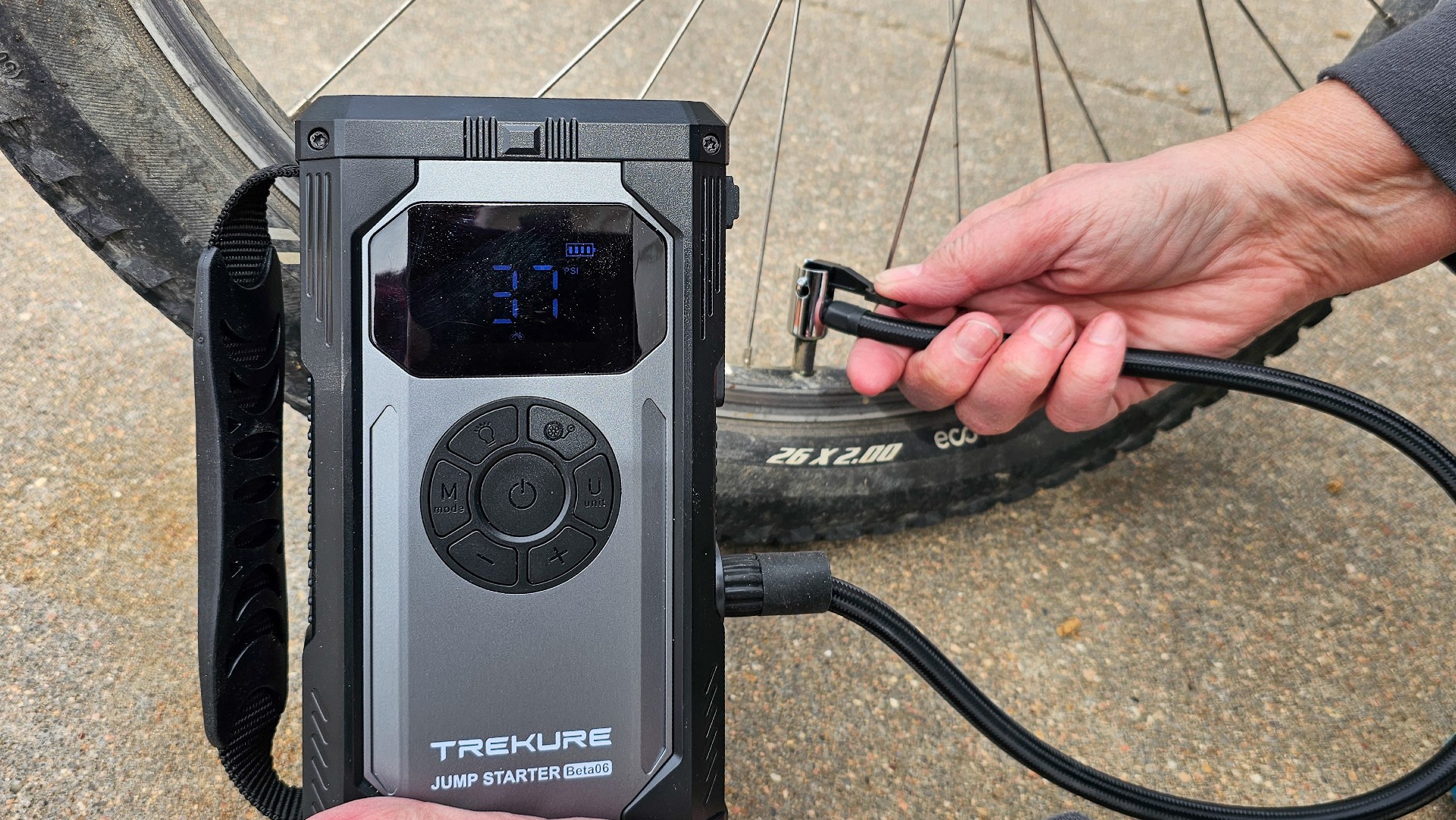
When choosing the best jump starter with an air compressor, there is some variance in the amount of pounds per square inch (PSI) offered by these models. Most models produce around 100 PSI—more than enough for any road vehicle’s tires. Most vehicle tires require just 30 to 40 PSI.
Some models offer 150 PSI or more, which is as much pressure as a traditional home air compressor. Are they necessary for typical vehicle repairs? No. But it might take these compressors less time to boost up a tire on the side of the road, so they could be worth the consideration and splurge.
Additional Features
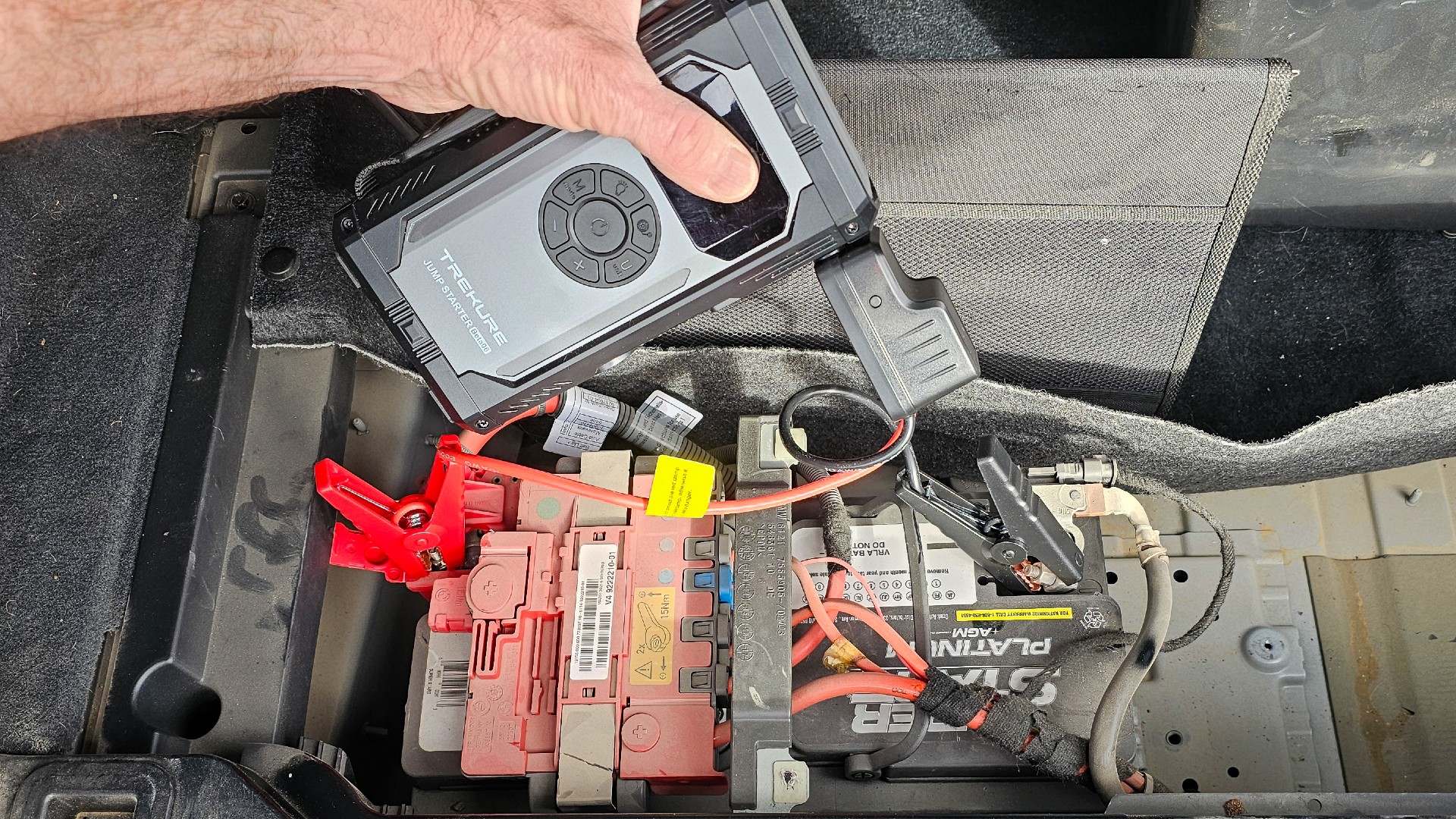
Several additional features might make a portable jump starter with an air compressor a bit more attractive to consumers.
- Many models include built-in flashlights or work lights. These lights don’t significantly drain the battery, so they’re a very convenient feature.
- Digital screens are becoming more common, and they display the battery level, compressor PSI, and other important information.
- Some of the more advanced models feature additional charging ports for USB-powered devices and 110V outlets for standard charging.
- Bluetooth functionality allows users to connect to mobile devices and stream audio while also charging a smartphone.
- Jump starters with air compressors don’t have tanks like a traditional portable air compressor, which keeps them lightweight and compact.
FAQs
Even with all of this background on choosing the best jump starter with air compressor, you might have questions. The following section is a collection of some of the most frequently asked questions about battery jump starters with air compressors, so be sure to check for an answer to your question below.stions about jump starters with air compressors, so be sure to check for an answer to your question below.
This depends on the vehicle, with smaller engines requiring just a few hundred amps and larger engines requiring 1,000 or more amps. Consider erring on the side of caution and choosing a car battery jump starter from this guide, as they all boast at least 1,000A.
Many units include their own AC adapters for charging via an outlet in a home garage. Others might have plugs to attach a standard extension cord for charging. Some also feature 12V ports for charging in a vehicle.
Most manufacturers suggest charging a jump starter with an air compressor every 30 days to ensure it’s in good working order.
Let your vehicle run for 15 to 30 minutes to allow the battery to recharge.
Yes, but it’s a good idea to take it indoors during extreme hot or cold weather.
You can expect to get 3 to 5 years of service, depending on quality and usage.
No, it shouldn’t if it is used correctly. If you’re worried about that, look for a unit that offers reverse polarity protection.
Meet the Tester
Tom Scalisi is a full-time DIY and construction writer for many of the largest websites in the industry, including BobVila.com, This Old House, Family Handyman, and Forbes. He’s a lifelong car guy who has had his fair share of dead batteries to deal with.
Glenda Taylor is a contractor, product tester, and writer focusing primarily on construction, DIY tools, and home appliances.

